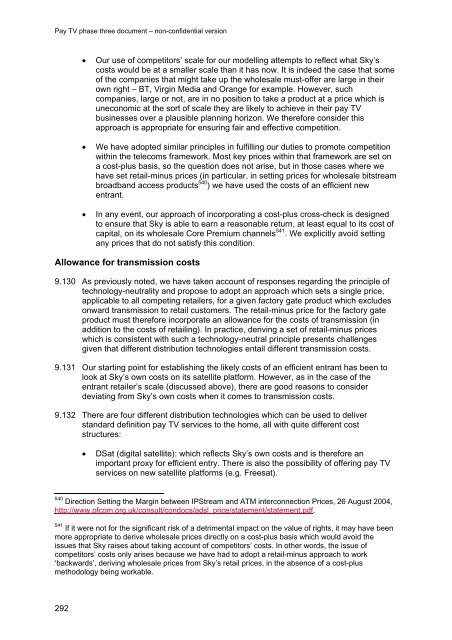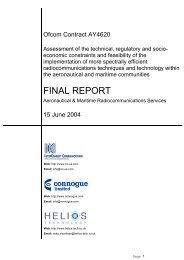Pay TV phase three document - Stakeholders - Ofcom
Pay TV phase three document - Stakeholders - Ofcom
Pay TV phase three document - Stakeholders - Ofcom
Create successful ePaper yourself
Turn your PDF publications into a flip-book with our unique Google optimized e-Paper software.
<strong>Pay</strong> <strong>TV</strong> <strong>phase</strong> <strong>three</strong> <strong>document</strong> – non-confidential version<br />
292<br />
� Our use of competitors’ scale for our modelling attempts to reflect what Sky’s<br />
costs would be at a smaller scale than it has now. It is indeed the case that some<br />
of the companies that might take up the wholesale must-offer are large in their<br />
own right – BT, Virgin Media and Orange for example. However, such<br />
companies, large or not, are in no position to take a product at a price which is<br />
uneconomic at the sort of scale they are likely to achieve in their pay <strong>TV</strong><br />
businesses over a plausible planning horizon. We therefore consider this<br />
approach is appropriate for ensuring fair and effective competition.<br />
� We have adopted similar principles in fulfilling our duties to promote competition<br />
within the telecoms framework. Most key prices within that framework are set on<br />
a cost-plus basis, so the question does not arise, but in those cases where we<br />
have set retail-minus prices (in particular, in setting prices for wholesale bitstream<br />
broadband access products 540 ) we have used the costs of an efficient new<br />
entrant.<br />
� In any event, our approach of incorporating a cost-plus cross-check is designed<br />
to ensure that Sky is able to earn a reasonable return, at least equal to its cost of<br />
capital, on its wholesale Core Premium channels 541 . We explicitly avoid setting<br />
any prices that do not satisfy this condition.<br />
Allowance for transmission costs<br />
9.130 As previously noted, we have taken account of responses regarding the principle of<br />
technology-neutrality and propose to adopt an approach which sets a single price,<br />
applicable to all competing retailers, for a given factory gate product which excludes<br />
onward transmission to retail customers. The retail-minus price for the factory gate<br />
product must therefore incorporate an allowance for the costs of transmission (in<br />
addition to the costs of retailing). In practice, deriving a set of retail-minus prices<br />
which is consistent with such a technology-neutral principle presents challenges<br />
given that different distribution technologies entail different transmission costs.<br />
9.131 Our starting point for establishing the likely costs of an efficient entrant has been to<br />
look at Sky’s own costs on its satellite platform. However, as in the case of the<br />
entrant retailer’s scale (discussed above), there are good reasons to consider<br />
deviating from Sky’s own costs when it comes to transmission costs.<br />
9.132 There are four different distribution technologies which can be used to deliver<br />
standard definition pay <strong>TV</strong> services to the home, all with quite different cost<br />
structures:<br />
� DSat (digital satellite): which reflects Sky’s own costs and is therefore an<br />
important proxy for efficient entry. There is also the possibility of offering pay <strong>TV</strong><br />
services on new satellite platforms (e.g. Freesat).<br />
540 Direction Setting the Margin between IPStream and ATM interconnection Prices, 26 August 2004,<br />
http://www.ofcom.org.uk/consult/condocs/adsl_price/statement/statement.pdf.<br />
541 If it were not for the significant risk of a detrimental impact on the value of rights, it may have been<br />
more appropriate to derive wholesale prices directly on a cost-plus basis which would avoid the<br />
issues that Sky raises about taking account of competitors’ costs. In other words, the issue of<br />
competitors’ costs only arises because we have had to adopt a retail-minus approach to work<br />
‘backwards’, deriving wholesale prices from Sky’s retail prices, in the absence of a cost-plus<br />
methodology being workable.
















